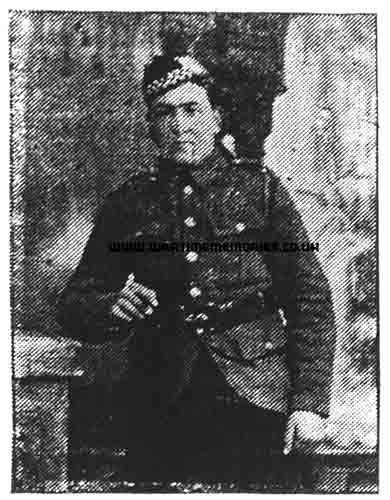Additions will be checked before being published on the website and where possible will be forwarded to the person who submitted the original entries. Your contact details will not be forwarded, but they can send a reply via this messaging system.
please scroll down to send a message
Pte. David Combe
British Army 1/7th Btn. Argyll & Sutherland Highlanders
from:Hoghill Farm, Oakbank, nr. East Calder
(d.14th July 1917)
David Combe was born in 1891, one of four children born to David Combe (Snr) and Christina Brown, who lived at Hoghill Farm, Oakbank, near East and Mid Calder in West Lothian, Scotland. As a young man he became a gardener on the Howden Estate and lived at Howden Cottages.
He was “attested†on 11th of December 1915 and sent to the Army Reserve. Finally mobilized on 10th of February 1916 he failed the medical, being graded as B(iii) and was returned to the reserve. `B' meant he was “free from organic disease, able to stand on lines of communication in France or in the tropics†and (iii) meant “Only fit for sedentary workâ€. He was finally mobilized on 17th of October 1916 at Glencorse Barracks near Edinburgh and sent for basic training at Kerwick in England. This completed, he was sent to Folkstone for embarkation to France on 23rd April 1917. He was now Private 326515 Combe, David.
On arrival, he was sent to the induction camp and hospital at Camiers Etaples near Boulogne-sur-Mer. Around 11th May he was posted to the 1/7th Argyll and Sutherland Highlanders. On the 29th May 1917 he was lightly wounded and sent back to the hospital at Etables. Evidently the wound was not serious as he was discharged on 7th June as A1.
According to a letter from the lieutenant of his platoon, David Combe was on duty in the front line trench when a “Boche†trench mortar round landed on his position. A piece of shrapnel hit him on the head and he was killed instantly. His comrades then carried him to a small cemetery behind the lines where he was buried in a grave marked with a simple wooden cross. He was reported “killed in action†on 14th of July 1917. The location is unknown. His remains therefore lie in an unknown Belgian field but he is remembered on panels 42 and 44 of the Menin Gate at Ypres.
